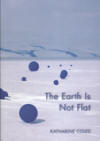The Earth Is Not Flat
The Earth Is Not Flat, Katharine Coles’s fifth collection of poetry, considers the meaning of discovery in the context of the Antarctic landscape. “If you wanted to be first / You live in the wrong time,” Coles writes in the book’s opening lines (“Self-Portrait in Hiding”). This desire to arrive first, to know first—and a contemporary inclination to question this desire—informs Coles’s wide-reaching poems recording her experience in Antarctica, made possible through the National Science Foundation’s Artists and Writers Program. In The Earth Is Not Flat, Coles invites her reader to undertake the unsettling experience of approaching the vast Antarctic landscape along with her, and to both push against and embrace a deeply-rooted desire to explore and know the world.
The Earth Is Not Flat, Katharine Coles’s fifth collection of poetry, considers the meaning of discovery in the context of the Antarctic landscape. “If you wanted to be first / You live in the wrong time,” Coles writes in the book’s opening lines (“Self-Portrait in Hiding”). This desire to arrive first, to know first—and a contemporary inclination to question this desire—informs Coles’s wide-reaching poems recording her experience in Antarctica, made possible through the National Science Foundation’s Artists and Writers Program. In The Earth Is Not Flat, Coles invites her reader to undertake the unsettling experience of approaching the vast Antarctic landscape along with her, and to both push against and embrace a deeply-rooted desire to explore and know the world.
Readers familiar with Elizabeth Bradfield’s 2010 collection Approaching Ice will find the extreme latitudes explored from a different angle in The Earth Is Not Flat. While Bradfield’s writing emerges from her years as a naturalist living and working in the Arctic and Antarctica, Coles’s work records the experience of the outsider. “When I get there at last, someone will look over my supplies clucking his tongue,” she writes in “Proposal.” This disappointment follows a list of preparations, including: “I will let machines read my heart and run until my breath fails,” and, “To close my eyes here at my table and imagine cold sky, drowning, wings that carry a body between.” Coles’s experience in Antarctica balances between these extremes—the limitations of the body and the far sweep of the imagination.
As a first-time visitor to the southernmost continent, Coles most frequently records her feelings of wonder and amazement in response to the landscape’s beauty and strangeness. In “All Day Long the Glacier Sings,” she writes:
Today, the glacier
Could tell us everything, if we
Would listen. We try,
Cocking our heads, not knowing
What or how to answer.
Coles’s desire to translate the landscape and to commune with it permeates other poems in the collection as well. In “Walking the Glacier” she writes:
If I forget myself, I could
Become spectacular. Could throw
Myself, whole hearted, into something
Or off.
Poems like this, which record Coles’s ecstasy, rank among the best in the collection because in them, she looks deeply at questions of human reactions to and interpretations of the natural world. She responds whole-heartedly to the landscape’s beauty, while also recognizing the human need to prove things “real . . . with scanners / And microscopes, instruments we assembled just for this” (“The Human Mind Did Not Create the Ice”).
Coles’s longing to connect with the landscape also leads her to reach out to the work of other artists, explorers, and scientists who also consider life at the poles. For example, in “Music of the Spheres,” an ekphrastic poem based on an installation at the South Pole by artist Lita Albuquerque, Coles writes:
So much
We have seen before is already gone
Or was never there and still
Vanished.
This feeling of something lost appears in another responsive poem, “Problems of Description in the Language of Discovery,” based on Coles’s conversations with mathematician Kenneth Golden:
I’m not here
To charm or conjure. I’m just watching,
As if, knowing what the numbers come to,
I might be able to tell you how they mean
Coles aspires to act as a bridge for the reader—between the reader and other thinkers or the Antarctic itself—but she also recognizes her inability to truly fulfill this role.
In “Fixing Antarctica,” she writes, “I keep taking the same photo over and over / As if to say Look, and Look.” These lines prove an apt summary of The Earth Is Not Flat: occasionally, the poems feel repetitive in the questions and situations they consider, but at the same time this repetition mirrors Coles’s own experience of Antarctica, an inhospitable landscape that nevertheless awes, as when a group watches as a penguin
Takes to the water and takes
Our breath—flight stitching wave to sky
. . . and each of us, turning
Head to follow, saying, Oh.
These breathtaking moments change Coles’s attitude about discovery by the end of the collection. After her opening statement on living “in the wrong time” to discover first, she later writes, in “Looking South,”
When
Will I imagine I’ve seen
Enough? Always so much
Left, no matter
Where on earth we’ve been.
From her knowledge of history and collective discovery, Coles moves toward a sense of the individual’s constant discovery of the world as she experiences things for the first time. “Nobody’s settled / Anything yet,” Coles writes in “Rumors of Topography.” The Earth Is Not Flat succeeds as a record—and an endorsement—of the individual’s capacity to discover the world anew.





